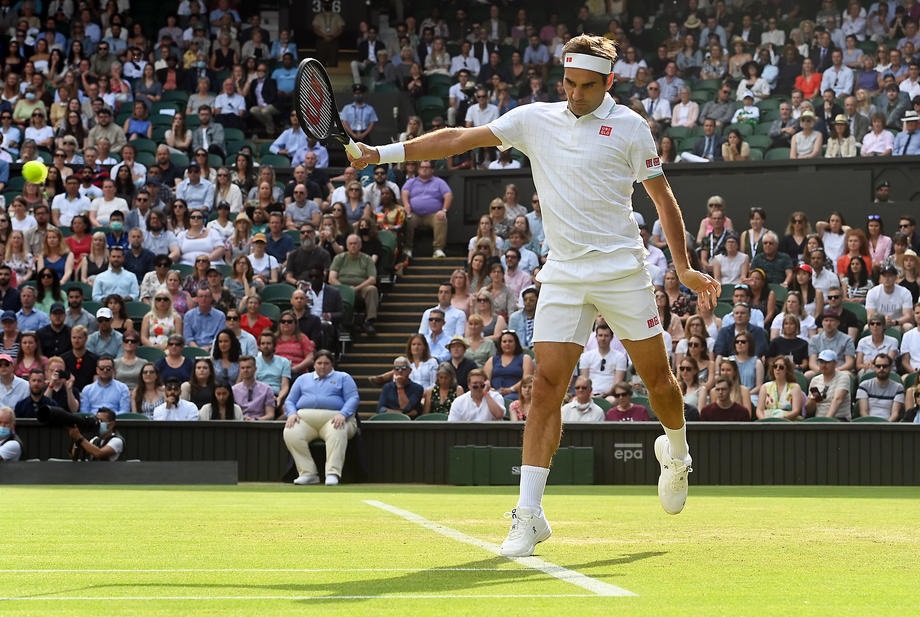- Ricky’s picks for this week’s ATP tournaments in Adelaide and Auckland
- Australian Open Qualifying Draws and Schedule for Monday, January 6, 2025
- Adelaide International Draws and Order of Play for Monday, January 6, 2025
- Taylor Fritz and Coco Gauff Lead USA Past Poland to United Cup Championship
- Adelaide International Draws and Order of Play for Sunday, January 5, 2025
- Brisbane International Draws and Order of Play for Sunday, January 5, 2025
- Coco Gauff, Taylor Fritz Lead Team USA into United Cup Final
- Opelka stuns Djokovic, sets up Brisbane semifinal against Mpetshi Perricard
- Brisbane International Draws and Order of Play for Saturday, January 4, 2025
- Happy New Year To All The Tennis World from 10sBalls (TennisBalls )
- Brisbane International Draws and Order of Play for Friday, January 3, 2025
- Brisbane International Draws and Schedule of Play for Thursday, January 2, 2025
- Gabriela Dabrowski Shares Breast Cancer Battle and Health Update
- Brisbane International Draws and Schedule of Play for Wednesday, January 1, 2025
- Noah Rubin’s “Behind The Racquet” with Brandon Holt • Tennis | 10sBalls
Indian Wells Random Notes
- Updated: March 20, 2018
Photo by Alejandro Gonzalez
The 2018 BNP Paribas Open gave us dynamic debuts, revitalized returns and an all-time champions box of Rod Laver, Pete Sampras and Sugar Ray Leonard.
We saw Serena Williams, Victoria Azarenka and Novak Djokovic launch comebacks, the Williams sisters square off and a women’s final between two future Grand Slam stars.
Here are some random observations from our time in Indian Wells.
We’ve seen this tourney from Palm Springs to La Quinta. to The a Hyatt, To Indian Wells The area was once a retirement community for the stars. (Dedi Arnav and Lucille ball were early developers there with the county club and hotel) For Juan Martin del Potro, it was a revival ground. Del Potro pulverized Milos Raonic in the semifinals then showed championship character denying three championship points to dethrone defending champion Roger Federer and capture his first Masters 1000 championship. Fearlessness and humility make del Potro a beloved champion. He has endured four wrist surgeries and enough setbacks to make Job raise a sympathetic eyebrow, yet Delpo doesn’t whine, he competes with all he has on a given day. This was a guy reduced to one-handed slice backhands when he initially launched his comeback from a third surgery to his left wrist. Though del Potro is not quite as explosive as he was when he made history defeating Rafael Nadal and Federer in succession to claim the 2009 US Open, he is undoubtedly a more complete player who plays with more nuance. The 2018 del Potro is a better volleyer, with a sharper slice and the ability to shift speeds more effectively than his younger self, which is one reason why del Potro is on course to eclipse his career-high rank of No. 4 achieved eight years ago and is a threat to win a Grand Slam this season. Del Potro raised his finals record vs. Federer to 4-2—if you can beat Federer in a final you can beat anyone in a final.
Roger Federer is not a morning person. Following the rare pre-noon start time for the semifinals, Federer looked unsettled, frustrated and ornery at times in his semifinal and final matches. The five-time champion conceded he probably should have lost the semifinal to Borna Coric, but will be annoyed at the fact he held three championship points and should have won the final vs. del Potro. Whether it was the sometime breezy and tricky conditions or the stress of trying to sustain his career-best 17-0 start to a season, Federer was a little jittery. His backhand return let him down and he wasn’t as precise with the running forehand. Still, Federer showed feisty resolve scraping past Coric and put himself in position to beat del Potro only to succumb to nerves and the Tower of Tandil’s battering ram forehand, which Federer sometimes challenged too much. This week showed us at age 36, Federer may be best suited to the best-of-five Grand Slam format — with a day of rest and recovery between rounds—rather than the grind of Masters’ scheduled where he played back-to-back days completing his rain-suspended, opening-round win over Federico Delbonis as well as the semifinals and finals. The 20-time Grand Slam champion explained why he still feels pressure to perform. “You do care about the moments, about the fans, what they think, how they portray you and you care for the result and you care for so many things,” Federer said. “So as little pressure as it seems to be there’s always pressure on the top guys. Expectations are there, but I’m definitely in a good place. I feel like I have less to prove today than in the past, but that doesn’t mean I don’t want it badly. But I need to have that drive to be successful, to be quite honest.”
Indian Wells has been a launching pad for young players. A 17-year-old Serena Williams beat Steffi Graf in a memorable 1999 final, a 20-year-old Ana Ivanovic took the 2008 title just three months before winning Roland Garros and a teenage Sloane Stephens won her first pro match at Indian Wells seven years before winning the US Open. It’s easy to see why both talented 20-year-olds Naomi Osaka and Daria Kasatkina inspire visions of future Grand Slam showdowns. Both are creative, crowd-pleasing players, skilled at spinning the ball into obscure corners.
The 44th-ranked Osaka roared through nine of the last 11 games overpowering Kasatkina in the final for her first career title. Osaka, who represents Japan but grew up in New York and Florida, has evoked comparisons to her tennis idol, Serena Williams. Working with coach Sascha Bajin, Serena’s former hitting partner, has paid dividends in that Osaka is fitter, exhibits more patient point construction and she trusts her game. The teenage Osaka had an itchy trigger finger and would often try to end points prematurely. The champion Osaka showed better match management skills and the belief she can hang in longer rallies with victories over Maria Sharapova, Karolina Pliskova and an absolute thrashing of world No. 1 Simona Halep. Osaka basically beat the desire out of the Australian Open finalist, who capitulated. Here’s why Osaka has a massive upside: Her volatile first serve is already one of the biggest in the game, she’s equally explosive off both forehand and backhand and shows she can finish at net. Two of Osaka’s biggest weapons—her T serve and crosscourt forehands—are high-percentage shots with plenty of spin over the lowest part of the net. While Osaka has evoked comparisons to Serena, her game is similar to fellow Yonex endorser Nick Kyrgios. Like Kyrgios, she can command matches with her serve, like Kyrgios she can shorten the backswing on her two-handed backhand and like Kyrgios she gets up for playing the stars on big stages.
Maria Sharapova suffered her third straight loss with an opening-round defeat to Osaka. Sharapova’s response to her slide? She amicably split with long-time coach Sven Groeneveld, who stood by her side during her 15-month drug suspension, (4 years total ) and pulled out of Miami with a forearm injury. It’s the second time in the last three tournaments the former world No. 1 has pulled out suggesting either her body is growing brittle or she just doesn’t feel ready to compete at the highest level. The problem for the 42nd-ranked Russian is she needs more match play but she’s not gaining traction in tournaments to get it. Four of Sharapova’s five losses this season have come to opponents outside the Top 40. If you read her memoir “Unstoppable” then know oversized obstacles bring out the best in Sharapova. However, given the fact her serve hasn’t been consistently cracking 105 mph in her recent matches, her transition game is suspect, she’s not comfortable closing at net and her flat strikes offer little margin for error, it’s tough to envision Sharapova turning it around anytime soon.
Procrastinators take time from blowing off working on your taxes to celebrate. Barbora Strycova and Su-Wei Hsieh signed up for the doubles draw 10 minutes before the noon entry deadline. Then the pair caught fire knocking off the top three seeds to take the title in their first tournament together. Playing old school doubles, the pair relied on guile, angle and finesse to take down some powerful opponents. Though they looks like major contenders, the pair may not play together any time soon. Both entered Miami with different partners. Since 25-time Grand Slam champion Martina Hingis retired last year, Hsieh has the softest touch and best hands of any WTA doubles player. Of course, Hsieh is much more than a doubles specialist as she showed knocking off world No. 3 Garbine Muguruza and Agnieszka Radwanska en route to the Australian Open round of 16. If you play doubles, be sure to see Hsieh play in person and you may well be mesmerized by what she can do with the ball.
John Isner and Jack Sock have spent a the early season embroiled in singles struggles. The pair joined forces to edge the Bryan brothers in a fierce and fun all-American men’s doubles final. Several players have said if Sock played doubles even semi-regularly, he could be the world No. 1 doubles player. “We have played four Masters Series ever together, and we have won two of them. I mean, I think Jack could win a couple of matches with you, I think,” Isner joked with the media after the title run. It’s the second Indian Wells doubles title for Sock, who partnered Vasek Pospisil to win the 2015 Indian Wells and 2014 Wimbledon titles. Sock showed a weird resentment toward doubles when asked about it at the Nitto ATP Finals in London last year. “I was never a doubles specialist, even though you guys think that for some reason. I feel like I’m a decent singles player. I’ve always been,” Sock said then. The thing Sock doesn’t seem to understand is he can be an even better singles player when playing doubles periodically because it empowers him to employ his touch, volley and skills closing at net into his singles play.
Simona Halep raised questions about her mental fitness to hold onto the top spot for an extended period of time. Halep’s mental meltdown vs. Osaka showed she’s still prone to periods of moodiness under pressure. It’s a pity because she fought so hard at the Australian Open and seemed committed to going all in mentally and emotionally, but looked detached and dismissive bowing to Osaka.
American tennis had cause for celebration. In addition to the all-American doubles final, Indian Wells gave us the latest Venus vs. Serena encounter, Sam Querrey’s run to the quarterfinals that put Q-Ball a couple of games from his first ever Masters semifinal before he fell to Milos Raonic and Sachia Vickery’s stunning upset of world No. 3. Garbine Muguruza. Twenty-year-old Taylor Fritz and 16-year-old Amanda Anisimova both showed star power with pulsating runs. Anisimova annihilated two-time Wimbledon winner Petra Kvitova on Stadium 1, snapping the Czech’s 14-match winning streak, and barely looked stressed doing it. “Look, she has a big game, which you can see. She has the strikes, so she can hit pretty fast shots,” Karolina Pliskova said after ending Anisimova’s run. “When you play without any pressure, you don’t think.” Fritz fought off match point in his opener vs. buddy Reilly Opelka, upset fellow NextGen star and US Open quarterfinalist Andrey Rublev and took down Fernando Verdasco in a third-set tie break thriller that rocked the stadium. Working with veteran coaches David Nainkin and Paul Annacone, Fritz looks stronger and more polished. His first serve is a major weapon and if he can improve his volley they’ll be more deep Masters runs in his future.






